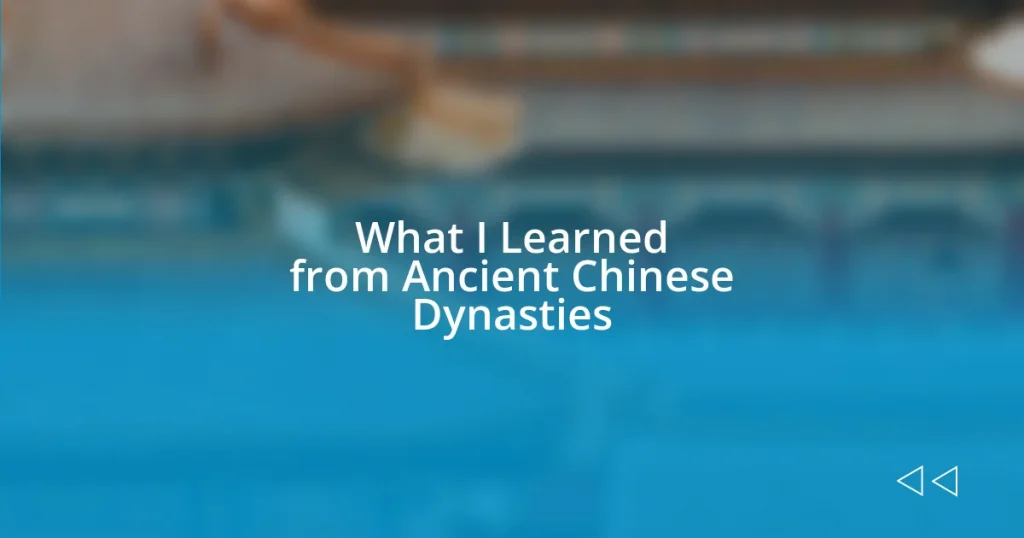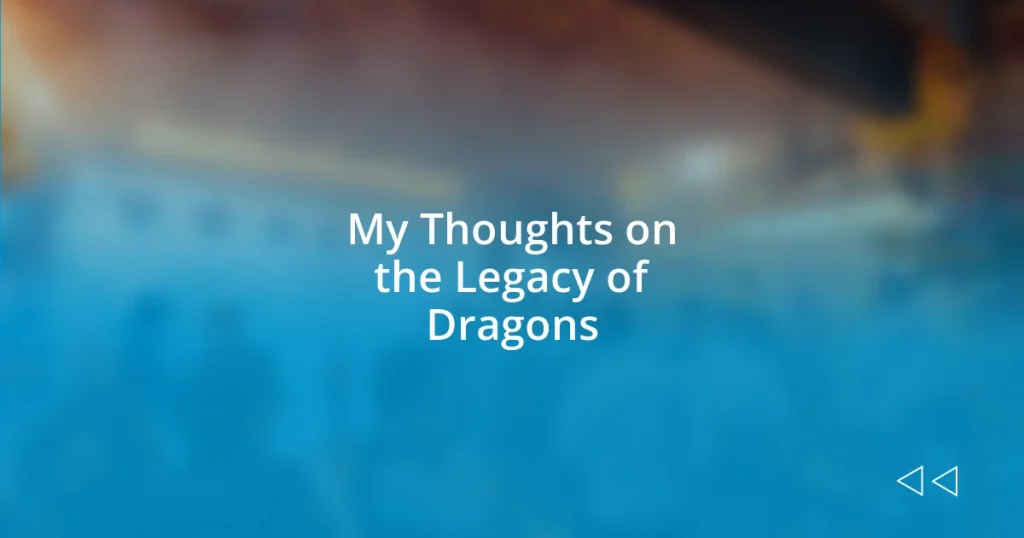Key takeaways:
- The centralized authority in ancient Chinese dynasties fostered diverse cultures under a unified governance, shaped by Confucian ideals that influenced social hierarchies and moral values.
- Major dynasties like the Qin, Han, and Ming made significant contributions, including unification of China, technological advancements, and cultural prosperity that laid the groundwork for modern Chinese identity.
- Modern Chinese society reflects ancient philosophies in social values and education, emphasizing collectivism, respect for elders, and the importance of continuous learning and balance in daily life.
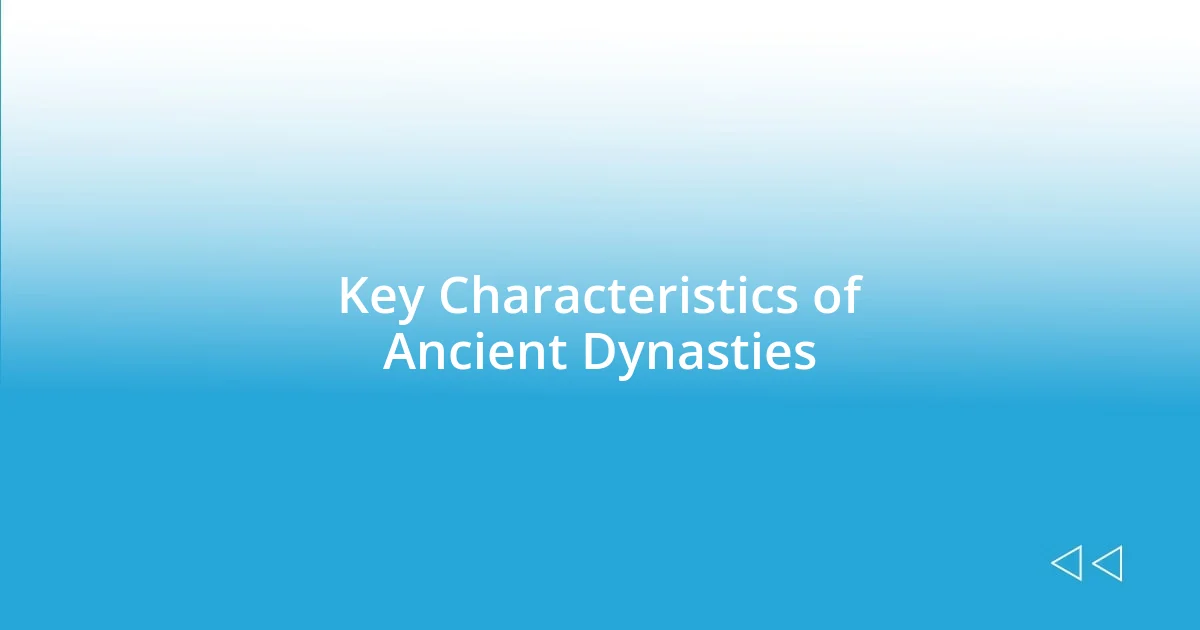
Key Characteristics of Ancient Dynasties
One of the most striking characteristics of ancient Chinese dynasties is their emphasis on centralized authority. I’ve always found it fascinating how a single ruler could unify vast territories and diverse cultures under a common governance. Have you ever thought about how challenging it would be to maintain control over such a large area? This often led to a rich blend of traditions, yet it also created tensions, as different regions had their unique customs.
Another key feature is the significant role of Confucianism, which shaped moral values and social hierarchies. I remember a lecture that delved into how these teachings influenced the way people related to each other, from leaders to common citizens. It’s intriguing to think about how a philosophical stance could impact daily life for millions. What about you—how do you think such ideas can still resonate in our societies today?
Lastly, the dynasties’ robust administrative systems showcased their advanced organizational skills. I often wonder how officials managed to keep everything running smoothly without the technology we have now. These systems allowed for tax collection, public works, and even the management of the Silk Road, which connected cultures and economies far beyond their borders. Doesn’t it make you appreciate how complex and interconnected history can be?
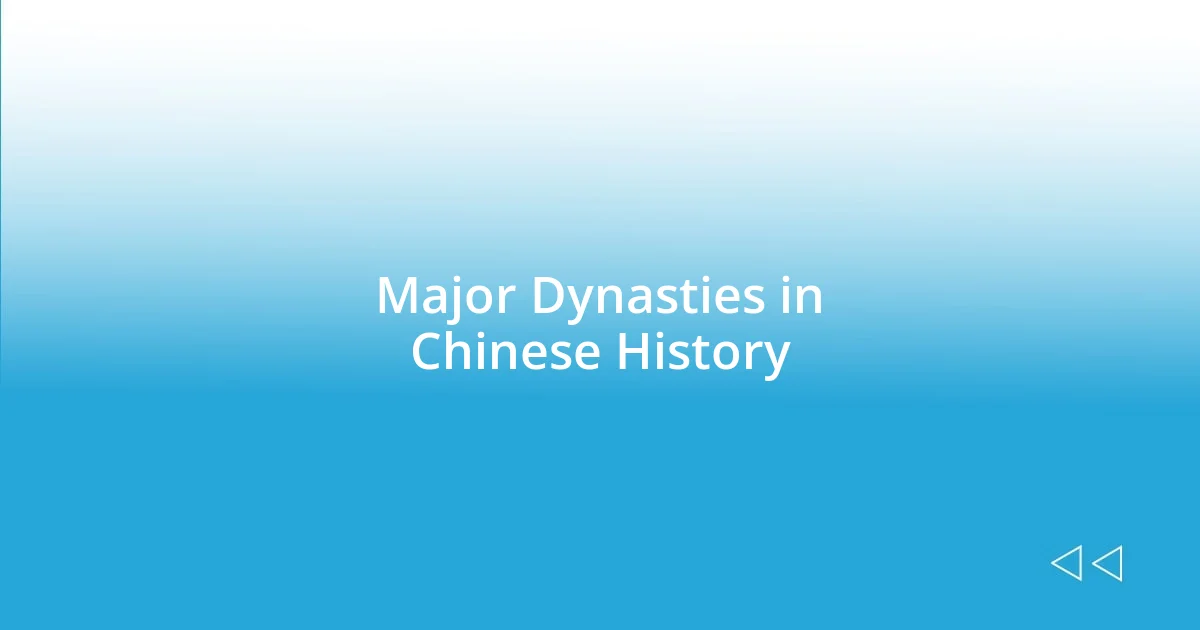
Major Dynasties in Chinese History
The major dynasties in Chinese history have significantly shaped the cultural and political landscape we recognize today. For instance, the Qin Dynasty, despite its short reign, pioneered the concept of a unified China and laid the foundation for future governance. I can’t help but admire how the Great Wall, constructed during this time, symbolizes both protection and ambition. Have you ever gazed at architectural feats and wondered about the determination it took to achieve them?
Moving on, the Han Dynasty is often dubbed the golden age of Chinese civilization. It’s remarkable how advancements in technology, art, and trade flourished under their rule. I once visited the ruins of ancient Han cities, and I was struck by the remnants of innovation, such as the early seismograph created by Zhang Heng. These developments not only enhanced life during that period but also set the stage for future innovations. Isn’t it inspiring to think about how one period can influence countless generations?
Lastly, the Ming Dynasty is another pinnacle in China’s historical timeline, renowned for its cultural and economic prosperity. I recall exploring the vibrant markets of Beijing, imagining how similar scenes existed centuries ago, bustling with trade and creativity. The Ming era’s exquisite porcelain and complex literature highlight the artistic spirit of the time. Don’t you think it’s fascinating how the art created centuries ago can still captivate us today?
| Dynasty | Key Contributions |
|---|---|
| Qin | Unified China, Great Wall Construction |
| Han | Technological Advancements, Trade Expansion |
| Ming | Cultural Prosperity, Artistic Achievements |

Political Structures and Governance
The political structures of ancient Chinese dynasties were often intricate and hierarchical, reflecting their need for control and stability. During my studies, I stumbled upon the examination system used in the Sui and Tang Dynasties, which allowed for talented individuals to rise through the ranks based on merit rather than birth. This meritocracy fascinated me; it felt like a significant leap toward fairness in governance. Isn’t it compelling how a focus on merit could inspire people to aspire for higher roles?
- The emperor held supreme authority.
- Bureaucratic structures facilitated governance through appointed officials.
- The civil service examination system emerged as a means to identify capable leaders.
- Confucian ideals established social and political hierarchies.
In contemplating the governance of these dynasties, I realize how essential local administration was to their success. A vivid memory of reading about the Tang Dynasty’s use of local governors sparked my curiosity about how these officials balanced the emperor’s wishes with regional autonomy. Their ability to adapt policies to local needs, while maintaining overall loyalty to the central power, seemed heroic at times. I can’t help but admire the dedication that these governors must have felt, knowing their positions could significantly impact their communities.

Cultural Achievements and Innovations
The advancements in the arts and sciences during ancient Chinese dynasties are truly remarkable. Take the invention of paper during the Han Dynasty, for example. I remember the first time I held a piece of traditional Chinese paper, marveling at how something so simple has transformed communication and creativity across the world. Isn’t it astonishing how such innovations can have ripple effects throughout history, influencing everything from education to art?
Exploring the cultural achievements of these dynasties led me to discover the profound impact of Chinese painting and calligraphy. The delicate brush strokes and flowing characters speak volumes about the values of patience and precision ingrained in their culture. I’ve begun to appreciate how each stroke serves not just as art, but as a means of expressing philosophical ideas. Have you ever considered how art can convey such deep messages beyond mere aesthetics?
Then we have the intricate craftsmanship of the Tang and Song Dynasties, where innovations in ceramics and textiles emerged. I recall when I stumbled upon a beautifully crafted Tang dynasty vase in a museum; it was as if it told stories of trade and cultural exchange through its intricate patterns. It’s incredible to think about how these artistic innovations not only served practical purposes but also became symbols of cultural identity. How much do you think our modern creations will be valued centuries from now? It’s a fascinating thought, isn’t it?

Lessons in Leadership and Strategy
Throughout my exploration of ancient Chinese dynasties, I’ve realized that effective leadership hinges on communication. A memorable instance was studying how Confucianism shaped decision-making processes. The emphasis on harmony and ethical governance resonated with me. It made me ponder: when leaders prioritize clear dialogue and ethical standards, how much more effective can they become? This approach not only builds trust but fosters a united front against challenges.
Moreover, the strategic use of alliances and military tactics in the dynasties stands out. I remember reading about the Wu Dynasty’s clever use of geography to outmaneuver rivals. Their ability to assess the terrain for strategic advantage taught me that understanding one’s environment is crucial in facing adversity. It begs the question: how often do we take stock of our surroundings when making decisions today? I believe it’s a vital lesson that can apply to many aspects of life.
Finally, studying the stability of dynasties reinforced the idea that a strong foundation is essential for sustainable leadership. The Song Dynasty, for instance, balanced their military might with cultural prosperity, creating a resilient society. This realization struck me deeply, reminding me that true leadership blends strength with cultural and intellectual growth. Isn’t it interesting how some of the best strategies are timeless, transcending eras and cultures? I’ve found that integrating these elements can lead to lasting success, even in today’s fast-paced world.
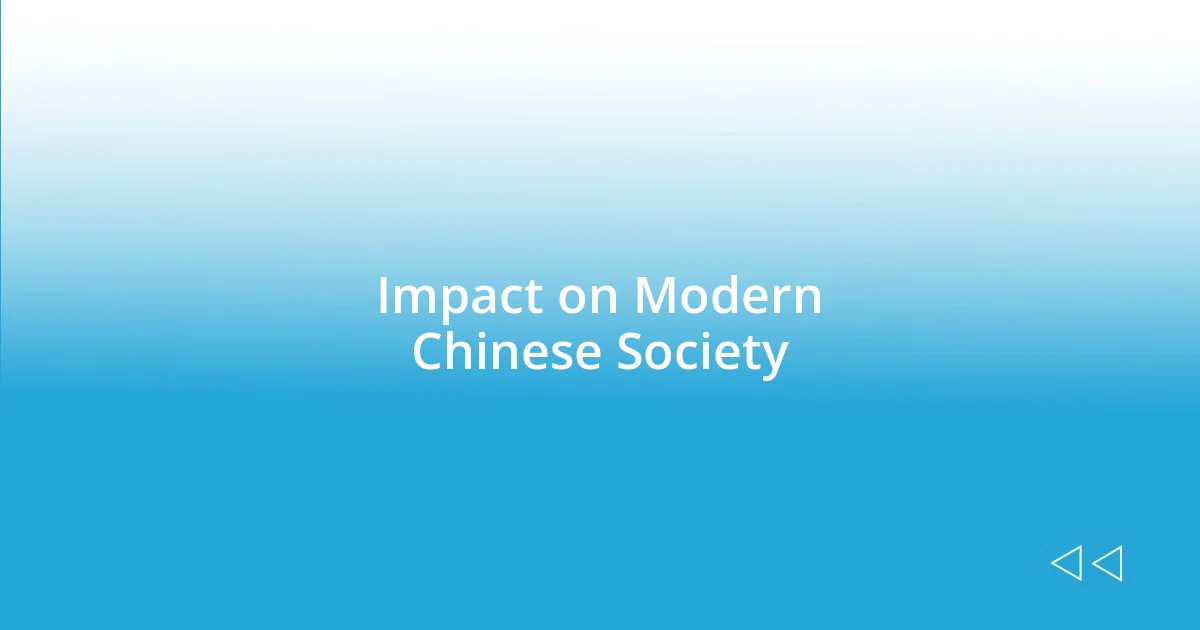
Impact on Modern Chinese Society
The influence of ancient Chinese dynasties on modern Chinese society is profound, particularly in terms of social values and education. I remember interacting with a group of students from China who shared how deeply Confucian principles shape their worldview. They spoke of filial piety and respect for elders with such passion that it truly struck a chord within me. It made me reflect: how often do we prioritize wisdom and respect in our own communities?
In contemporary China, the emphasis on collectivism over individualism can be traced back to these ancient philosophies. There was this moment when I observed a local marketplace bustling with activity; everyone seemed to collaborate harmoniously, embodying that age-old spirit of community. I couldn’t help but wonder if this unity stems from a historical understanding that together, we achieve more. Doesn’t it seem that our roots often dictate the branches of our lives?
Moreover, the historical significance of ancient innovations, such as traditional medicine and martial arts, remains a vital part of everyday life. When I attended a Tai Chi class for the first time, I felt a powerful connection to centuries of practice and philosophy. It was as though each movement embodied the essence of balance and mindfulness that has endured through the ages. Have you ever experienced something that felt like a bridge to the past? It’s astonishing how these ancient practices continue to echo in our lives, nurturing both body and spirit.
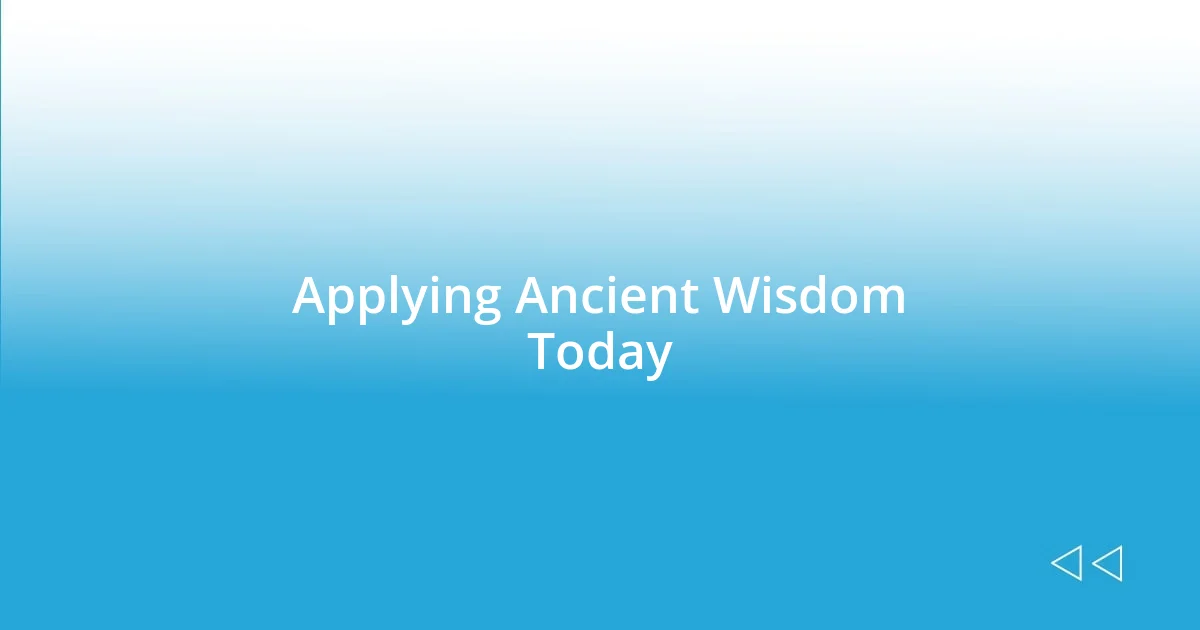
Applying Ancient Wisdom Today
When I think about applying wisdom from ancient Chinese dynasties today, I often reflect on the importance of balance. During a meditation retreat I attended, we explored ancient philosophies that emphasize the yin and yang principle—finding harmony in oppositional forces. This concept sparked a realization in me: how essential is balance in our daily lives, especially with the chaos we often face? It’s a reminder to seek equilibrium, whether in work-life commitments or emotional health.
Additionally, the teachings of Laozi on simplicity struck me as particularly relevant in our hyper-connected world. One afternoon, I decluttered my space inspired by his concept of ‘wu wei,’ or effortless action, which encourages leading a simple life. This process renewed my focus and energy, igniting a joy that made me ask: how often do we encumber ourselves with unnecessary complexities? Simplifying our environments and routines can lead to increased clarity—a lesson as poignant now as it was centuries ago.
Finally, I find the ancient emphasis on continual learning and self-cultivation so inspiring. While volunteering at a local community center, I noticed how older generations shared their knowledge and skills with younger folks, reminiscent of traditional apprenticeship models. It made me think: how do we value knowledge transfer in our society today? Cultivating a mindset of lifelong learning isn’t just beneficial; it’s vital. Perhaps embracing this ancient practice fosters resilience and adaptability that we need more than ever in our rapidly evolving world.











